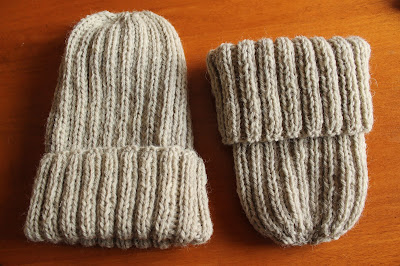Sandoval Hats and The Blessing Way
The knitting: Sandoval Hat by Robyn Devine
The novel: The Blessing Way by Tony Hillerman
I've been in a hat-making mood lately, so I tried out the Sandoval Hat pattern and liked it! I made it in the adult and child sizes and they're waiting in the gift stash now. I had bought a skein of Lion Brand Fisherman's Wool last month, and can get a few more hats out of it because there are 465 yards per skein. I used Size 7 needles for gauge, and enjoyed this straightforward knit. You just K2P2 for as long as you're supposed to and then there's just six rounds of decreasing.
 |
| I think the decreases are pretty tidy, but if they weren't nice-looking enough (it can be tricky with such rapid decreases) a pompom would easily cover the area. |
I read The Blessing Way recently, and then I forgot to photograph it. I would happily buy any colorway that featured the colors of Hillerman paperbacks. (I actually checked Etsy. No luck.)
I thought I had read all of the Leaphorn and Chee novels, but when I started reading them in order I was surprised to find out I never read The Blessing Way. It's not my favorite, but it's a good introduction. There's a lot to love from these novels--the pacing, the descriptions of nature, the relationships between characters. My favorite thing is how often people meet in diners and have discussions over coffee and eggs. I can't get enough of the descriptions of people eating old man meals and washing them down with hot black coffee. It's such a simple secondhand pleasure but I feel a thrill of delight every time it happens.
The Blessing Way features just Joe Leaphorn, and the story goes between focusing on him and his old college buddy, anthropologist Bergen McKee. For a series that features main characters who typically try to live in harmony with nature and their community, this has a surprising amount of Leaphorn bumping up against suspected witches and/or pointing his friend toward reports of witch-like activity for purposes of study. In fact, there's a lot about The Blessing Way that doesn't strike me as being "very Leaphorn and Chee", so to speak. Hillerman himself wrote an explanation in a forward to a reprint of his next novel, Dancehall of the Dead. Apparently he wrote The Blessing Way in an attempt to improve his writing skills so that he would know enough to write what he felt would be his bigger and better book, The Fly on the Wall. (I've never read it.)
"Thus, Navajo Tribal Policeman Joe Leaphorn was a very minor character in the version of The Blessing Way I'd sent off to Joan Kahn at Harper & Row and there wasn't much effective use of the Navajo religion. But Joan Kahn, bless her, required substantial rewrite. By then I had seen some of the possibilities I was missing in Navajo Country. In the rewrite I beefed up Leaphorn's role and inserted more Navajo material. Even so, I was aware had missed an opportunity." (i and ii, introduction to Dance Hall of the Dead, 1991 ed.)
Still, this book has themes and characters that readers love from the series as a whole. The trading post, sings, Leaphorn using his anthropology degree, quiet and methodical police work, unhurried conversations with elders, long drives at dawn, an aversion to even being around evil, and clear lines between drawn before the reader between people humbly trying their best, desperate people making poor decisions, and people who have been turned evil by greed and rage.
I'm not going to bother much with describing the plot of The Blessing Way other than to say that once I realized this wasn't going to exclusively feature Joe Leaphorn, I settled in to enjoy the parallel storyline centered around Bergen McKee and was content to follow along, secure in the knowledge that the two stories would converge.
They did, and I was satisfied.





Comments
Post a Comment